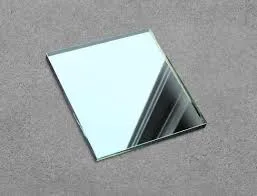Frosted brown glass has emerged as a versatile and elegant material, gaining popularity in a variety of product markets. Its unique attributes, such as the sleek matte finish and rich brown hue, make it an attractive choice in industries ranging from home decor to packaging. Let's delve into the appeal of frosted brown glass, explore how it enhances product aesthetics and practicality, and leverage industry insights to understand why it stands out.

Frosted brown glass is often associated with sophistication and subtlety, providing an air of elegance without the ostentation of more reflective materials. This makes it ideal for home decor, where consumers seek understated elegance that coordinates well with various interior styles. Whether used in the form of lamp bases, vases, or decorative panels, frosted brown glass introduces an organic warmth to spaces, blending seamlessly with both modern minimalist and traditional classic interiors.
One of the defining characteristics of frosted brown glass is its ability to diffuse light softly. This attribute not only creates a soothing ambiance but also offers a practical benefit in light fixtures, reducing harsh glare and creating a more inviting atmosphere. This is particularly beneficial in indoor settings where mood lighting is essential, such as living rooms and dining areas. Designers often favor frosted brown glass for this reason, recognizing its capacity to transform mundane lighting solutions into artful installations.

In the realm of packaging, frosted brown glass is celebrated not only for its aesthetic appeal but also for its functional properties. It offers UV protection, making it an excellent choice for preserving the quality and extending the shelf life of products sensitive to light, such as perfumes, essential oils, and gourmet foods. The opacity of the frosted finish also provides a layer of privacy, making it a favored choice for personal care products where discretion is often desired. Brands increasingly opt for frosted brown glass containers to signal quality and sophistication, setting themselves apart in a crowded marketplace.
From an environmental perspective, frosted brown glass is a champion of sustainability. Glass is infinitely recyclable, reducing the environmental impact compared to plastic or other synthetic materials. This aligns with the growing consumer demand for sustainable packaging solutions. By selecting frosted brown glass, companies demonstrate their commitment to eco-friendly practices, thereby enhancing their brand image and customer trust.
frosted brown glass
Expert craftspeople in the glass industry have refined the techniques needed to produce frosted brown glass, ensuring consistency and quality. The process involves acid etching or sandblasting to achieve the frosted texture, with each method offering slight variations in finish and appeal. Producers emphasize the importance of mastering these techniques to maintain the integrity and durability of the glass, defining quality standards across the industry.
Consumer experiences further validate the status of frosted brown glass as a material of choice for numerous applications. Users frequently praise its tactile pleasure and the way it complements natural and artificial light. Many have noted its versatility, as it pairs well with wood, metal, and stone, offering endless possibilities for integration into various design schemes.
The testimonials capture a universal appreciation for its understated elegance and functionality—a testament to its broad appeal. Frosted brown glass embodies a blend of tradition and modernity, leveraging its classic aesthetics while meeting contemporary needs for sustainability and versatility.
In conclusion, frosted brown glass stands out due to its unique combination of beauty and functionality. It aligns with modern design trends to provide a timeless appeal in a variety of contexts, from home decor to product packaging. By embracing this material, industries can elevate their offerings, respond to consumer demands for sustainability, and ensure their products remain relevant in an ever-evolving market.



